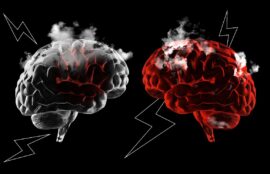
Whether you remember it or not, you dream every night. Sometimes they’re happy, other times sad, often bizarre, and if you’re lucky, you’ll get a sexy dream once in a while.
They’re a normal part of sleep — something we spend one-third of our life doing. While experts are still divided on what our dreams mean, research has given us some very eye-opening information about dreams.
Here are 45 surprising facts about dreams, ranging from interesting to the stuff of nightmares.
How We Dream
REM is the sweet spot
Our most vivid dreams happen during rapid eye movement (REM) sleep, which happens in short episodes throughout the night about 90 to 120 minutes apart.
Morning is better
Longer dreams occur in the morning hours.
Weekends help you remember
You’re more likely to remember your dreams on weekends or days when you sleep in, because each episode of REM sleep is longer than the last.
Your muscles are paralyzed
Most of your muscles become paralyzed during REM sleep to prevent you from acting out your dreams.
Pictures are most common
We dream mostly in pictures, with the majority of dreams being mainly visual with little sound or movement.
Recurring dreams have themes
Recurring dreams in children are mostly about:
- confrontations with animals or monsters
- physical aggressions
- falling
- being chased
We don’t all dream in color
Around 12 percent of people dream in black and white.
What We Dream
Strange is normal
Many of our dreams are strange because the part of the brain responsible for making sense of things shuts down during dreaming.
Our day informs our dreams
Most of our dreams are linked to thoughts or events from the previous day or two.
Faces are familiar
You likely only dream about faces you’ve already seen in person or on TV, according to Stanford University.
Low stress means happy dreams
You’re more likely to have pleasant dreams if you’re experiencing low stress and feel satisfied in your real life.
Sex Dreams
Not everything is what it seems
Morning wood has nothing to do with sexy dreams or stimulation. Nocturnal penile tumescence causes men to have three to five erections every night, some lasting 30 minutes.
Women can have wet dreams
Men aren’t the only ones who have wet dreams. Women can release vaginal secretions from arousal and even orgasm when having a sexual dream.
Sex dreams aren’t that common
Approximately 4 percent of men and women’s dreams are about sex, according to research.
Sex dreams are usually about one thing
Most sex-related dreams are about intercourse.
Sleep position matters
You’re more likely to dream about sex if you sleep face-down.
This might also make you dream about other things
Sleeping face-down isn’t just associated with more sex dreams, but also dreams about:
- being locked up
- hand tools
- being naked
- being smothered and unable to breathe
- swimming
Men dream about variety
Men dream of sex with multiple partners two times more than women.
Women dream about celebrities
Women are twice as likely to have sex dreams about public figures compared to men.
Sleep sex is real
Sleep sex, also called sexsomnia, is a sleep disorder much like sleep walking, except instead of walking, a person engages in sexual behavior like masturbation or intercourse while asleep.
Nightmares And Other Scary Stuff
Kids have more nightmares
Nightmares usually begin between the ages of 3 and 6, and decrease after the age of 10.
Women are more prone to scary dreams
Women have more nightmares than men during their teen and adult years.
Nightmares occur at a similar time at night
Nightmares occur most frequently in the last third of the night.
You could have a condition
If you have recurring nightmares that happen often enough and are distressing enough to impact your ability to function, you may have a condition called nightmare disorder.
Sleep paralysis is a thing
Around 8 percent of the general population experiences sleep paralysis, which is the inability to move when you’re in a state between sleep and wake.
Your feelings come out in dreams
For example, you’re more likely to experience negative dreams about a lost loved one if you’re suffering from post-traumatic symptoms, guilt, or blame over their death.
The holidays can be rough
Grief dreams, which are dreams about deceased loved ones, are more common during the holidays.
Night terrors can be frightening
Night terrors are episodes of intense fear, screaming, and even running around or acting aggressive while asleep.
Children have them more frequently
Almost 40 percent of children have night terrors, though most outgrow them by their teens.
Adults can still have them
Around 3 percent of adults have night terrors.
Eating late isn’t helpful
Eating before bed makes nightmares more likely, because it increases your metabolism, signaling your brain to be more active.
Medications play a role
Certain medications, such as antidepressants and narcotics, increase the frequency of nightmares.
Negative emotions take a toll
Confusion, disgust, sadness, and guilt are more often the driving force behind nightmares than fear, according to research.
Random Cool Facts
We all see things
Blind people see images in their dreams.
Fido dreams, too
Everyone dreams, including pets.
We are forgetful
People forget 95 to 99 percent of their dreams.
We dream a lot
People over the age of 10 have at least four to six dreams every night.
We may be prophetic
Some believe dreams can predict the future, though there isn’t enough evidence to prove it.
We dwell on the negative
Negative dreams are more common than positive ones.
You may be able to control your dreams
You may be able to learn to control your dreams by using techniques for lucid dreaming.
Sleep talking usually isn’t nice
Swearing is a common occurrence in sleep talking, according to a 2017 study.
Sudden muscle spasms aren’t your imagination
Hypnic jerks are strong, sudden jolts, or the feeling of falling that occurs just as you’re falling asleep.
This may cause falling sensations
Hypnic jerks may be the cause of dreams about falling, which is one of the most common dream themes.
Tooth dreams could have a bigger meaning
Dreams about your teeth falling out may be caused by undiagnosed dental irritation, like bruxism, rather than a premonition of death like old folklore suggests.
By far the most mind-boggling fact of all
Though they’ve been trying to figure it out since the beginning of time, researchers don’t know why we dream or what purpose it serves, if any.
The Psychology Of Dreams
Everyone, at one time or another, has wondered what their dreams mean.
Dreaming is the most extensively studied cognitive state. While some experts believe that dreams have no meaning and serve no function, others believe that our dreams do mean something.
A number of theories exist on what dreams mean, some of the more recognized theories include:
- Psychoanalytic theory.In this theory, dreams are believed to represent unconscious desires, wish fulfillment, and personal conflicts. Dreams give us a way to act out unconscious desires in the safety of an unreal setting, because acting them out in reality would be unacceptable.
- Activation-synthesis theory.Popularized in the 1970s, this theory suggests that dreams are just a byproduct of your brain trying to process random signals from your limbic system, which is involved in your memories, emotions, and sensations.
- Continual activation theory.This is the idea that our brains are continuously storing memories, even when we’re asleep. It suggests our dreams provide a place to hold our memories while they make the transition from our short-term memory to our long-term memory.
These barely begin to scratch the surface of dream interpretation theories. Here are some other interesting theories on the meaning of dreams:
- Dreams are threat simulations that help prepare you when faced with threats in real life.
- Dreams are your brain’s way of collecting and clearing out useless information from the day to make room for new information the next day.
- Dreaming goes back to an evolutionary defense mechanism of playing dead to fool enemies. This explains why our bodies are paralyzed while dreaming, but our minds remain highly active.
The Bottom Line
Experts may not have any concrete answers as to why we dream and what function dreams serve.
What we do know is that everyone dreams, and even our really strange dreams are perfectly normal.
About the Author:
Adrienne Santos-Longhurst is a freelance writer and author who has written extensively on all things health and lifestyle for more than a decade.
Original article here






















Sorry, the comment form is closed at this time.